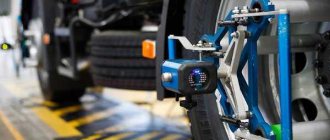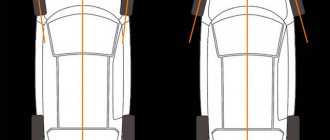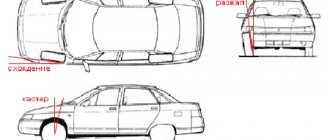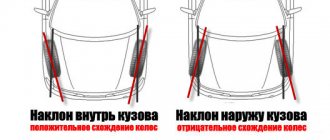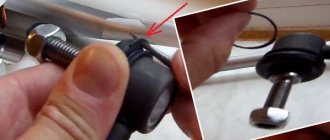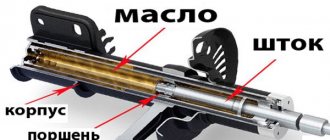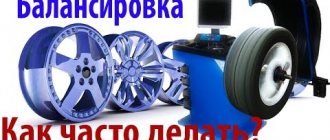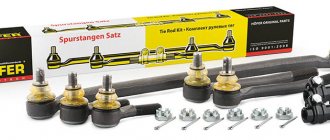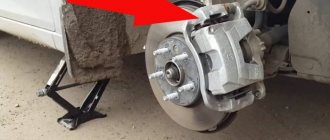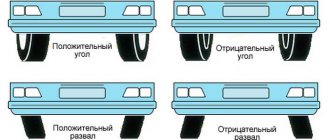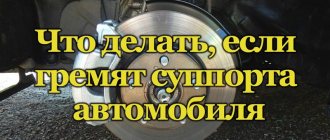An automobile suspension is an element of a car that is in contact with the road through the wheels, which means that it is this part of the equipment that bears the bulk of the load. The stability and controllability of the car, which is integral to the safety of movement, depends on the correct adjustment of the wheel alignment. When should this operation be performed? For example: is it necessary to do a wheel alignment after replacing struts or stabilizers, ball joints, changing tires, etc. All these questions should be answered in more detail.
How to understand that the wheel alignment is poorly adjusted
A serviceable car drives smoothly and evenly - it does not pull to the side or throw when braking. But when the settings go wrong, on a straight road the steering wheel pulls away and the car “floats”. In addition, tires wear out quickly. Even an amateur will understand when the camber is out of balance. If you notice one of these deviations, then it’s time to go to the service station:
- The tires squeak even when turning slowly.
- When you drive straight, the car gradually pulls to the side.
- To drive straight, you have to keep the steering wheel turned slightly.
- Tires wear out quickly.
Often the reason is not due to natural wear and tear, but to interference with the suspension components. After the repair, the wheel alignment becomes misaligned and the car drives poorly - you need to look for a service station again to fix it. Unpleasant. Find out after what repairs the camber is adjusted, and immediately do everything correctly.
The car pulls to the side after changing tires: reasons
If, after changing tires, the car begins to behave inappropriately, this is a consequence of incorrect settings of the elements of the car’s chassis. Usually the reason that the vehicle pulls to the side after replacing the ramps is one of these factors.
- Incorrect pressure. When installing new tires, car enthusiasts often forget about the need to check the tire inflation. If the car starts to drive crookedly, one of the tires may be flat.
- Tires installed incorrectly. Each slope has an inner and an outer side. There is a clear signpost for directional models. If the wheels on the same axle are positioned differently, the steering wheel will pull.
- Uneven wear. On the right side there is a good version, on the left there is a “dead” ramp, naturally the car will pull to the side.
- Problems with the brake mechanism. When replacing wheels, you can accidentally break the brake line, which will lead to the part jamming.
- Broken wheel alignment. The old tire could have gotten used to it and not react to the wearability violation.
After changing tires, the car pulls to the right when you let go of the steering wheel: what to do?
If the steering wheel moves to the right after changing tires, it is necessary to check the primary causes.
- Correct inflation - there should be equal pressure all around.
- Correct tire installation. Some craftsmen may mix up the wheels during installation.
- Brake system. A wedging caliper blocks the disc, which leads to slip.
- Uneven wear on the slopes. It is tedious to measure the tread depth with a caliper - it should be the same.
- Wheel alignment. Broken rods can cause the vehicle to roll away.
What to do if the steering wheel pulls to the left after changing tires
You can correct the situation when the car drifts to the left after changing tires in the same way as when it drifts to the right. Moreover, if nothing creaks, you don’t have to go deep into the suspension; usually the problem is on the surface.
Pressure, alignment, brakes and correct tire installation are studied in the same way.
Replacing ball joints
These parts directly affect the position of the wheels relative to the road surface, so after installing new ball joints, wheel alignment must be done. The reason for this is that when the old part gradually wears out, play appears, which you eliminate by adjusting the toe and camber. And if you decide to change the ball joints, the play disappears. Therefore, the wheels will stand differently and their position needs to be adjusted.
And also interesting: TRANSFER CASE AND SHANK SEAL OF FRONT AXLE NIVA 2121 21212302052 AvtoVAZ. Wholesale and retail.
Is a wheel alignment necessary after replacing the springs?
Springs ensure smooth suspension travel, absorb road potholes and set the vehicle's ground clearance. Springs tension the suspension and body between each other.
Over time, this suspension element sags. Each time we adjust the wheel alignment to a new position of the springs, however, this leads to the fact that when installing a new spring, the ground clearance changes and drags the rest of the suspension elements along with it. Thus, the wheel camber is lost. So after replacing the springs, it is highly recommended to do a wheel alignment.
Replacing the CV joint
The constant velocity joint is not part of the suspension and does not affect it, but when replacing it, the angle of the wheels is always adjusted.
When they take out the CV joint, they disassemble the fastening of the steering tip or ball joint. After installing a new part, the tip is twisted, which throws off its settings. Often it is completely broken. And if you don’t align, the car will drive to the side.
The angle of inclination of the wheels is also influenced by the condition of the steering tip itself. When replacing it or repairing the steering rack, the camber is also adjusted.
What does incorrect wheel alignment lead to?
Everything is simple, if this parameter is disabled, then:
- The trajectory of the car is incorrect; it will pull to the right or to the left. Which is no longer safe.
- Increased tire wear on the wheel will require replacement more often.
- Incorrect position of the steering wheel in the car, which is also inconvenient.
To be honest, this is dangerous primarily due to the trajectory of movement, if at low speeds in the city you can hardly notice it, but at speeds of 60 km/h, the car may already be “wobbling” in different directions, that is, the steering wheel, you are holding straight - and the car is walking along the road. Well, the wear on the wheel will be simply enormous; even new tires can be ruined in a season.
How to determine that your car's wheel alignment is incorrectly adjusted
There are a number of symptoms that clearly indicate that the car’s wheel alignment settings have been disrupted:
- When entering a turn at low speed, you can hear the wheels squealing;
- To move the car in a straight line, the steering wheel must be tilted slightly to the right or slightly to the left from the central axis;
- If you let go of the car's steering wheel, the car begins to spontaneously pull to one side;
- Car tires wear out quickly.
If the symptoms described above appear, it is necessary to adjust the wheel alignment. A similar procedure is performed in almost any service center.
When will you have to do a wheel alignment?
So, if you have changed or repaired the steering rack, then you definitely won’t be able to avoid visiting a wheel alignment specialist. You will also need to go if you have changed: steering rods or ends, levers, ball joints, front struts. In addition, if you increased the ground clearance of your car by installing spacers or replacing springs with shock absorbers, you also need to readjust the wheel alignment angles.
This procedure is quite expensive, around 1.5-2 thousand rubles, but it must be done. Good handling is inextricably linked with the safety of using a car and you should not skimp on your own health or even life. After self-repair, it is quite acceptable to drive a certain distance to the place where the wheel alignment is done; this will not cause any harm to the car.
The principle of operation of silent blocks
Silent blocks are rubber-metal hinges that are the connecting element of the chassis system. They dampen the vibrations that occur, preventing their spread, and also give a certain degree of freedom to the parts connected to each other. This is one of the most important elements of a car’s suspension, requiring replacement if it malfunctions. The silent block consists of three parts: two metal bushings and a rubber or polyurethane gasket between them.
The exact mounting locations of silent blocks and their number are selected depending on the design of a particular car model. These elements are located on the front and rear axles. On the front axle, silent blocks are installed in the places where the lever connects to the hub and to the body, as well as at the attachment points of the anti-roll bar. On the rear axle, the places where silent blocks are placed are the levers and the attachment points for the torsion beam and shock absorbers. In addition, silent blocks can connect the steering rack with rods, as well as the body with the gearbox and engine.
The service life of silent blocks is usually 100 thousand km, but in bad road conditions this resource can be significantly reduced. After this, the silent block needs to be replaced. If extraneous noise appears in the chassis while driving, if there is a noticeable deterioration in the vehicle's handling, as well as in the case of typical tire wear and wheel play, you will most likely have to resort to repairs. In this regard, many people have a question: is it necessary to adjust the wheel alignment after repair? Let's try to understand this issue.
When replacing shock absorber struts and stabilizers
Although the shock absorber struts are part of the front suspension, they are one of its main parts. However, they have practically no effect on “taxiing”; they do not affect steering rods, ball joints, etc. — when replacing a shock absorber, it is not recommended to unwind them at all. This applies to both front-wheel drive vehicles (MacPherson strut) and rear-wheel drive vehicles of our VAZs. We just remove the strut, there are three bolts on the front drive and two on the bottom and pull it out - install a new one and drive on.
The same issue applies to stabilizers; they generally have little effect on wheel alignment. These are generally bones that simply “collect” the suspension into a heap, making it work in a balanced and equal way. They can be changed in half an hour, with your own hands, after which you don’t need to do anything.
Is it necessary to do a wheel alignment after replacing summer tires with winter ones?
If you are replacing worn summer tires with new winter tires, it is recommended to perform the procedure. Different tread heights can affect the position of the suspension arms, but only slightly. In this case, the car enthusiast himself decides whether it is worth going to the service station.
Is it necessary to do camber when changing the wheel size - yes. Rearranging narrow tires instead of wide ones and vice versa causes a violation of the suspension geometry, which subsequently causes the car to pull to the side or eat up the ramp. At the same time, the procedure is recommended even if it was recently done.
If there is no change in the wheel parameters, you should go to the wheel alignment only as a routine inspection. You can see how detailed the wheel alignment looks in the photo.
When replacing a CV joint
To be honest, the CV joint itself does not affect the car’s suspension, it is responsible for transmitting torque to the wheels, that is, replacing it should not affect the wheel alignment. However, I receive a lot of letters in the mail - that after replacing it, the steering wheel was not in the position it was in, or the car began to drift to the right or left. Why is that?
It’s very simple - when replacing a CV joint, craftsmen have to unscrew the fastening of the ball joint or often the steering end, or maybe both at once. You just can't remove the CV joint without removing these two (or one) ends (always different). They are difficult to remove, and often the hub simply sticks to the ball joint.
After replacement, they should be put back in their place, but you can inadvertently change the settings or break the tips! Because of this, it will pull or the steering wheel will not be in the correct position - we are going to “camber”. Also, after such a repair, we immediately check the ball and steering ends, perhaps due to incorrect removal actions you broke them. The moral is this - go to proven stations, and not to “Uncle Vanya” in the garage.
What I would like to say in conclusion is that the suspension of modern cars is a fairly durable mechanism (unless, of course, you deliberately kill it), it can travel many thousands of kilometers, usually problems begin closer to 100,000 km. Until this date, most likely you will not need to check the wheel alignment; replacing tires and even struts play practically no role here, so go for a ride - don’t be afraid of anything.
I’ll just give you one piece of advice right away, when buying a new car, it is advisable to immediately check the wheel alignment, before the first 2000 km - tell the mechanic that it seems like the car is dragging, and the steering wheel is not level, let them check (sometimes even this should be done at expensive cars, my friend has a new Tiguan, the settings were messed up, although I bought an expensive package).
Now there’s a useful video, let’s watch it.
And that’s all for today, read our AUTOBLOG.
votes, average: 3.73 out of 5)
Also interesting: Kenguryatnik on Chevrolet Niva: selection criteria, material, installation
FakeHeader
Comments 15
Do it of course. If the steering wheel is not level, don’t even think about it. After replacing the ball joint, you need to. My opinion!
Thank you, I did it not long ago, I said that maybe the ball mount is different and that’s why. Now the steering wheel is straight, half a year warranty and everything is like in a pharmacy.
It seems not... but it’s everyone’s business.
I was surprised myself, although I know that when replacing the ball joint there is no effect? Thanks for your feedback. Well, before the replacement, the steering wheel was exactly a hundred pounds! I changed the right one and leaned to the right ((
I firmly say yes! I changed it and the steering wheel went to the left, so yes
Thank you, I'm not the only one)
There was a case. After replacing the ball joint, my rods came loose. I take back the words I said above. The steering wheel also became crooked. I immediately noticed that the car was shaking a lot. I made it, another 10 km and an accident. Jack up the front. Wheels spin, toward you, away from you, left, right. Perhaps, but not a fact.
Guys, question. Is it necessary to do a wheel alignment after replacing the ball joints? It seems to me no, someone just says that it is necessary. A wheel alignment after replacing the ball joints.
Wheel alignment and struts
Here we have to make a separate point, because there is no consensus on whether it is worth doing an alignment after replacing them: there are too many nuances. At first glance, the struts do not affect the wheel alignment in any way. However, for example, when replacing support bearings, shock absorbers and springs on front-wheel drive cars, you have to disconnect the steering tip. The fact is that in the old rack the hole for it will be at least slightly broken, and you will put the old tip in the new structure.
The second, more important point: a separate replacement of the spring, when a new part is installed in the old rack, where it puts different pressure on its other elements. All this is especially true for old cars, the owners of which can be recommended to replace the struts along with the steering tips, so that later the wheel alignment procedure does not have to be carried out twice. If the strut assembly changes (shock absorber-spring), then the likelihood of needing toe-in and camber adjustment is low.
Wheel alignment: what it is, how to set it correctly, and what will happen if you don’t do it
1 / 2
2 / 2
Stance, baby: pronounced negative camber is an integral attribute of some automotive subcultures
Therefore, near-zero settings, in theory, have a positive effect on stability, and “minus camber” allows you to “tumble” into turns even better, but can already lead to accelerated wear of the inner tire tracks. That is why, in contrast to athletes, both car designers and ordinary “breakdown” specialists prefer near-zero values.
However, depending on the design and kinematics of the suspension, the rigidity of the elastic elements, track width, wheel offset and many other factors, the wheel alignment angles on different machines differ markedly. Moreover, they can vary even within the same model depending on the type of suspension (regular or sports) and tire size.
How are wheel alignment angles adjusted?
On many modern front-wheel drive cars, the camber angles of the front wheels are specified by design, and the caster (the longitudinal inclination angle of the strut) is not adjustable, so all adjustment comes down to checking and adjusting the toe.
However, this was not always the case - on the same “eight” with which all other cars of this platform grew up, not only the wheel alignment, but also the caster were adjusted. It is interesting that the tolerances were quite large, and the repairmen did not always change all the angles when making adjustments, preferring in many cases not to touch the caster - they say, there is a lot of fuss and there is not much use.
Factory parameters of Samara angles look like this: front wheel camber = 0°±30′, toe = 0°15′ ± 10′ and caster = 0°20±30′0. As you can see, the tolerances are really quite large - according to factory standards, the camber can “walk” within one degree, and a caster of fifty “plus” minutes has the legal right to “go into the minus”.
Front suspension of the VAZ-2108 - classic MacPherson strut without subframe without subframe
The manufacturer’s tolerances in Samara are quite large, so the “average” result of a visit to the stand looks something like this. As you can see, all parameters fit into the “green” range
Some motorists claim that they can notice deviations in minutes (!) without any stand - just by carefully looking at the car from the front...
What does caster affect?
The situation with the caster is no less interesting. A little higher, we remembered that at zero tilt angle the stand stands strictly vertical - that is, the wheel with the hub does not move anywhere relative to the vertical. With negative caster, the rack at the top seems to lean forward, and the wheel, accordingly, goes back. If it's positive, it's the other way around.
On front-wheel drive VAZs, for example, the caster parameter is changed using adjusting washers, which are placed under the front suspension elements - the trailing arm brackets (braces).
Caster in Samara is set using several washers
The longitudinal braces of the VAZ-2108 suspension are attached to the brackets at the front, and to the transverse arms at the rear. That's why they affect caster
By removing the washers, the rack can be tilted back within a degree, and the wheel, on the contrary, can be shifted relative to the center of the arch towards the front bumper. In reality, however, the opposite picture is usually observed - on many “older” Samaras, “tens”, Priors and Kalinas, the wheel “moves” towards the front door due to impacts and metal fatigue, and it is not always possible to return it to its place, even if you remove all the washers.
This is what zero caster looks like: the wheel stands in the wheel arch symmetrically with respect to the bumper and fender
This is no longer a caster, but a death sentence on the front suspension and even the body. It won't be possible to put the wheel back in place with a little effort.
The greater the angle of inclination of the rack, the more stable a front-wheel drive (and not only) car behaves at high speeds. Positive caster contributes to less “wobble” of the car, which becomes less sensitive to ruts and irregularities.
Caster is important not only for its direct impact on the speed characteristics of the car, but also because it affects the toe and camber angles, which change depending on the inclination of the strut. Therefore, you need to start adjusting the angles of the front wheels with the caster. Then comes the camber adjustment, and lastly it is necessary to adjust the toe-in, remembering the interconnection of these parameters with each other.
When changing caster, you need to unwind the longitudinal braces of the suspension. This takes time and effort - especially if the car is old
Which angles to choose?
Usually, the choice of wheel alignment angles from the permissible range is the prerogative of the wheel alignment specialist himself. And this is not always good, since many of them, having been doing their work for years, are guided by some internal stereotypes, which often contradict theory, but in practice lead to a deterioration in the driving performance of the car and premature wear of the tires. Therefore, the final printout numbers should be treated with great attention, and in some cases, do not hesitate to give recommendations.
What should you set the angle of the stand if it is adjustable? On a standard suspension and with a “normal” driving style - the maximum permissible positive, that is, 0°50′ for a front-wheel drive Samara, and on other front-wheel drive vehicles it is better to set the caster “more positive” - within tolerances, and if this parameter is adjusted, of course . This will provide the car with better directional stability at high speeds and will lead to “self-stabilization” of the steering wheel in a near-zero position. A slight deviation from factory tolerances is also acceptable - for example, an increase in caster to one degree (60-65′).
Your corners" may look something like this
Surprisingly, the modern stand even “knows” that Samara was produced in two generations!
True, you will have to pay for a “clear zero” by the fact that when turning, the steering wheel will become somewhat heavier (there is no power steering!) and will try to return more sharply to its previous position. However, you can get used to such a new feature of the machine in just a few minutes.
As for the camber, other “city racers” often “camber the front wheels to the minus” by up to one degree or more. However, at the same time, the car will become more “nervous” and sensitive to the slope of the road, because of which the steering wheel can literally “tear out of your hands” (especially on large and wide wheels!). Another price to pay for “sporting ambitions” is premature wear of the internal tracks - the tires are “like a house”!
The camber of the front wheels on Samara is adjusted using an eccentric bolt (position 3 in the figure) on the front shock absorber housings
It is best if the camber of the front wheels after adjustment has a “slight hint of minus” - that is, within -0°5-10′ per side. True, setting this parameter with such pinpoint accuracy on a Soviet-Russian machine is not so easy, and not all masters agree to spend their working time on such fun.
Setting up all front wheel alignment angles on a VAZ takes longer than on cars like the Renault Logan
Adjusting toe-in in Samara is a rather troublesome process (especially on the driver’s side), so some wheel alignment specialists even make similar special tools on their own (!)
When adjusting toe on front-wheel drive VAZs, it is also best not to deviate too much from near-zero values, remembering that even with a small vehicle load (driver and passenger), it begins to change by about 5-7 minutes, and in which direction exactly (to the “plus” "or "minus") depends on the position of the steering rack "whiskers" on a particular car.
Notice how the toe and camber angles change when partially loaded! (the first photo is with an empty car, the second with a driver weighing 65 kg)
Before adjusting the toe, the steering wheel must be set strictly horizontally and fixed, for which special devices are used at the service station
What happens if you don't do them?
In most cases, it is recommended to check the wheel alignment angles at least once every 30,000 km and immediately after the car has fallen into a large hole with a wheel or is involved in even a small accident. After all, both the first and second can lead to displacement of suspension elements, which will disrupt the toe-in, caster or camber parameters.
What happens if you don’t do them at all? Nothing good, of course. At a minimum, the car will behave worse both on a straight line and in turns, because deviation of any of the parameters affects both the stability of the car and its controllability. Secondly, the wrong angles will cause the car to start to pull to the side, so the driver will have to hold the steering wheel with more force in order to maintain a straight motion.
When the toe-in of the left wheel is so bad (the parameter highlighted in red), the car drives “somehow strangely”, constantly scouring the road, and the steering wheel simply does not return back! If you leave everything as is, then the tread will last for literally a couple of thousand kilometers.
It happens that the car is not just pulled to the left or to the right, but when moving it constantly “yaws”, deviating back and forth from a straight trajectory. In addition to the fact that driving such a car will not be very pleasant, the owner will very quickly discover that the wheels on the axle where the wheel alignment angles are incorrect wear out very unevenly and very prematurely.
Wear on the inner tracks is the result of large negative camber
There are known cases when, due to an incorrect wheel alignment, the projector of an almost new tire literally “melted before our eyes,” disappearing in just 10-15 thousand kilometers!
When does wheel alignment not help?
It is not always possible that even a qualified specialist on a correctly adjusted stand (and this is very important!) will be able to set the wheel alignment angles within the tolerances specified by the manufacturer. This is usually hampered by worn suspension parts that have noticeable play. Catching minutes where, during movement, parts “walk” by whole degrees is a rather pointless exercise. Therefore, an experienced “breaker” usually begins with a primary (that is, “rough”) diagnosis of the chassis, carefully examining the rubber-metal elements and checking them for mutual movement. In many cases, before visiting the wheel alignment stand, it is necessary to visit a general repair station to replace worn suspension parts. And only by “shaking up the chassis” can you try to achieve the required wheel alignment angles.
It happens that the suspension is fine, but you still can’t set the toe-in, camber or caster. The reason is irreversible deformation of the body, which happens after a severe accident or due to corrosion of power elements. And if in the first case, at least theoretically, a slipway can help, then on a strong “rotten” machine, a little bloodshed cannot solve the problem, and a lot of it doesn’t make sense.
Sometimes even after the corners are set correctly, the car still pulls to the side. In this case, you need to try to rearrange the wheels (or better yet, change the suspicious pair), since often due to deformation of the frame or heterogeneity of the breaker layers, the tire becomes “crooked”
Survey
Have you done a wheel alignment recently?
Your voice
Total votes:
Steering rack and ends
It is also necessary to check this parameter when replacing them. After all, these are almost the very first culprits of incorrect wheel alignment. Moreover, if you simply removed the rack without making any changes to it, for example, simply changing the boot, or adjusting the clamp - this is one thing, the parameters may not be lost. But if the tips were changed, that’s completely different.
The steering tips regulate the toe-in; they are the ones that are “twisted” at stations, so when replacing them, procedures are mandatory - remember this! If it is not aligned correctly, there will simply be enormous wear on the tires of the wheel, and control will suffer, specifically.
Incorrect wheel alignment adjustments
Incorrect adjustments of these two parameters are sure to have unpleasant consequences. Let's consider each case separately.
In the case of negative camber, increased wear on the inner part of the tires may be observed, since the bulk of the car's weight will fall on this part. With positive camber, on the contrary, the outer part of the tires. All this means accelerated tire wear, which means early replacement, which is not economically feasible.
When adjusting the camber, a balance must be achieved such that the wheel alignment angles are level when the driver is behind the wheel.
Toe-in leaves an unpleasant imprint on the steering. By changing the position of the wheels relative to the steering wheel, you can change the trajectory of the car without resorting to the help of that same steering wheel. That is, if the car should move in a straight line, when you release your hands from the steering wheel, then it will move away from the given trajectory.
However, it doesn’t matter how the toe-in is set, whether it’s negative or positive, if it’s set incorrectly, then the car’s steering response will be very poor.
A common sign of misalignment is tire squealing when cornering, even at low speeds.
Wheel angles
In order for the car to drive straight and not turn anywhere on its own, it is necessary that all its wheels are installed strictly at the correct angle. During suspension repairs, the previously set angles are lost and for this reason, before driving anywhere, it is necessary to go through the wheel alignment again.
This procedure includes adjusting the wheels vertically - camber, as well as adjusting them horizontally - toe. If you neglect this rule and set the wheels “by eye,” this will lead not only to rapid wear of the tire tread, but also to very poor handling.
What is wheel alignment
The concept of “toe-in” refers to the angle between the plane of rotation of the wheels and the longitudinal section of the car. There are positive and negative wheel alignment:
- Toe-in is called positive when the front parts of the wheels are at a smaller distance from each other than the rear parts;
- Toe-in is called negative when the rear parts of the wheels are at a smaller distance from each other than the front parts.
With incorrectly set wheel toe, wheel wear increases significantly, much more significantly than with incorrectly set camber.
